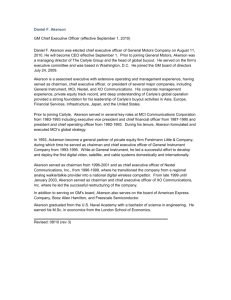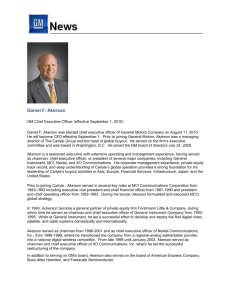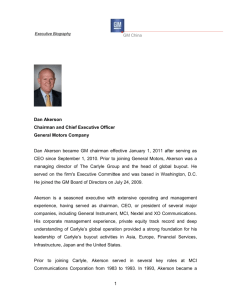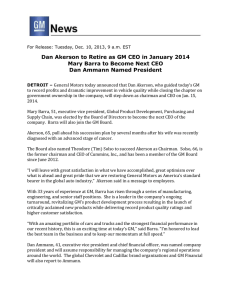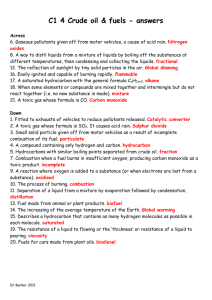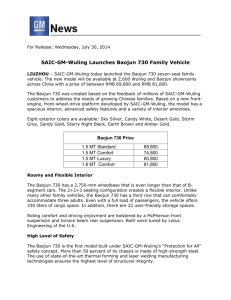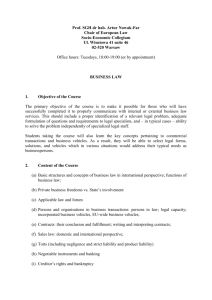Word - Gm - General Motors
advertisement
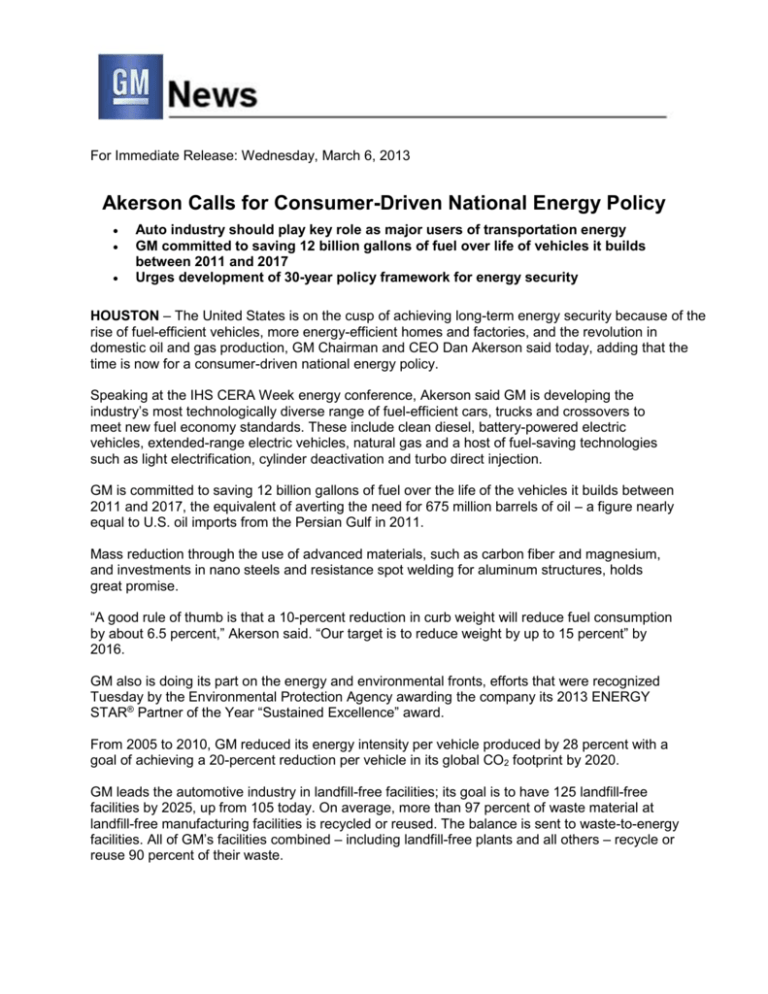
For Immediate Release: Wednesday, March 6, 2013 Akerson Calls for Consumer-Driven National Energy Policy Auto industry should play key role as major users of transportation energy GM committed to saving 12 billion gallons of fuel over life of vehicles it builds between 2011 and 2017 Urges development of 30-year policy framework for energy security HOUSTON – The United States is on the cusp of achieving long-term energy security because of the rise of fuel-efficient vehicles, more energy-efficient homes and factories, and the revolution in domestic oil and gas production, GM Chairman and CEO Dan Akerson said today, adding that the time is now for a consumer-driven national energy policy. Speaking at the IHS CERA Week energy conference, Akerson said GM is developing the industry’s most technologically diverse range of fuel-efficient cars, trucks and crossovers to meet new fuel economy standards. These include clean diesel, battery-powered electric vehicles, extended-range electric vehicles, natural gas and a host of fuel-saving technologies such as light electrification, cylinder deactivation and turbo direct injection. GM is committed to saving 12 billion gallons of fuel over the life of the vehicles it builds between 2011 and 2017, the equivalent of averting the need for 675 million barrels of oil – a figure nearly equal to U.S. oil imports from the Persian Gulf in 2011. Mass reduction through the use of advanced materials, such as carbon fiber and magnesium, and investments in nano steels and resistance spot welding for aluminum structures, holds great promise. “A good rule of thumb is that a 10-percent reduction in curb weight will reduce fuel consumption by about 6.5 percent,” Akerson said. “Our target is to reduce weight by up to 15 percent” by 2016. GM also is doing its part on the energy and environmental fronts, efforts that were recognized Tuesday by the Environmental Protection Agency awarding the company its 2013 ENERGY STAR® Partner of the Year “Sustained Excellence” award. From 2005 to 2010, GM reduced its energy intensity per vehicle produced by 28 percent with a goal of achieving a 20-percent reduction per vehicle in its global CO2 footprint by 2020. GM leads the automotive industry in landfill-free facilities; its goal is to have 125 landfill-free facilities by 2025, up from 105 today. On average, more than 97 percent of waste material at landfill-free manufacturing facilities is recycled or reused. The balance is sent to waste-to-energy facilities. All of GM’s facilities combined – including landfill-free plants and all others – recycle or reuse 90 percent of their waste. These activities generated about $1 billion in annual revenue, and in 2011 alone, 2.5 million metric tons of waste from landfills – the equivalent of 38 million garbage bags – were eliminated. “Everywhere you look there are opportunities to seize the energy high ground,” Akerson said. “Indeed, our leaders have been presented with an historic opportunity to create a national energy policy from a position of strength and abundance.” The pillars of such a plan must include: Energy diversity to avoid dependence on any one fuel or energy source. Continued development of all forms of domestic energy, including renewables, is required. Energy efficiency should remain a core component to allow the impact of prosperity and population growth. Continue to make meaningful, long-term investments in nascent technologies to drive CO2 emissions even lower. Akerson called on President Obama to immediately appoint a Blue Ribbon Commission to develop a 30-year policy framework for energy security with progress reviews every five years. To truly understand and make these changes sustainable, he said the presidential commission needs to include a broad cross-section of energy producers and energy consumers. And the commission should have a straightforward charge: “Develop a plan to improve our standard of living by extending the duration of the natural gas and tight oil ‘dividend’ for as long as possible.” General Motors Co. (NYSE:GM, TSX: GMM) and its partners produce vehicles in 30 countries, and the company has leadership positions in the world's largest and fastest-growing automotive markets. GM’s brands include Chevrolet and Cadillac, as well as Baojun, Buick, GMC, Holden, Isuzu, Jiefang, Opel, Vauxhall and Wuling. More information on the company and its subsidiaries, including OnStar, a global leader in vehicle safety, security and information services, can be found at http://www.gm.com. ### CONTACTS: Greg Martin GM Communications 202-744-6285 greg.a.martin@gm.com Jim Cain GM Communications 313-407-2843 james.cain@gm.com
